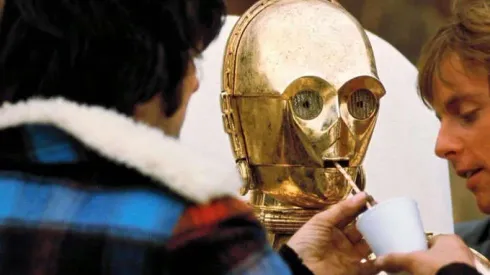Before CGI and digital wizardry took over Hollywood, blockbuster filmmaking was a mix of ingenuity, grit, and pure creativity. The sets were real, the stunts were dangerous, and the actors often worked through incredible challenges to bring iconic stories to life. These behind-the-scenes photos from classic blockbusters reveal the camaraderie, craftsmanship, and chaos that shaped some of the most unforgettable movies ever made.
Scarface (1983)
On the set of “Scarface,” Brian De Palma guides Al Pacino through the legendary staircase shootout scene. De Palma initially doubted Pacino’s ability to embody Tony Montana, but his electrifying audition erased all skepticism. Pacino’s dedication to authenticity, including his Cuban accent and mannerisms, was unmatched, although his perfectionism and repeated retakes often slowed production and tested the director’s patience.
The Exorcist (1973)
At just 14 years old, Linda Blair formed a close bond with director William Friedkin while filming “The Exorcist.” Known for his intense style, Friedkin also acted as her friend and protector, shielding her from public backlash and guiding her through the film’s most challenging scenes. Blair later credited him with changing her life and shaping her career.
Django Unchained (2012)
Quentin Tarantino gets hands-on while “capturing” Django’s gun at his leg, literally shaping the shot with his own hands. Directing “Django Unchained” pushed him emotionally, as he wrestled with depicting slavery and the harsh realities of the era. Tarantino aimed for historical realism, consulting Sidney Poitier and immersing himself in research, all while managing the scale and cost of his most expensive film to date.
The Matrix (1999)
In one of the most unforgettable moments of “The Matrix,” Neo and Agent Smith soar toward each other in slow motion, guns raised, in a gravity-defying showdown. The scene, a perfect blend of martial arts choreography and groundbreaking visual effects, captures the film’s mind-bending approach to action.
The Godfather (1972)
For the legendary tollbooth ambush in “The Godfather,” James Caan endured one of the most dangerous setups of the entire film. In an interview with Variety, he revealed that 147 squibs were sewn into his jacket to simulate Sonny’s brutal death — the most the effects crew had ever used on a single actor. Caan admitted the scene terrified him but joked that he pushed through “because there were girls on set” and he didn’t want to look scared.
The Lion King (1994)
To make “The Lion King” feel truly alive, the 1994 animation team went beyond imagination. They studied real lions up close—bringing some into the Walt Disney studios, visiting zoos, and watching hours of documentary footage. Every movement, from a playful pounce to a majestic stride, was carefully observed so the animated lions could capture the realism and spirit of their wild counterparts.
The Thing (1982)
On the set of “The Thing,” director John Carpenter collaborates with special effects wizard Rob Bottin, whose groundbreaking practical effects redefined creature design. Using intricate animatronics, puppetry, prosthetics, and even everyday materials like latex, jelly, and melted plastic, Bottin and his team created the film’s terrifying transformations entirely in-camera.
The Dark Knight (2008)
What if, instead of being visited by James Gordon, Harvey Dent had been visited by Batman in the iconic moment when he’s revealed as Two-Face? We’ll never know, but this behind-the-scenes photo sparks a fun “what if.” While Aaron Eckhart’s career continued mostly outside the spotlight, his performance in Christopher Nolan’s masterpiece remains unforgettable.
Fight Club (1999)
In this quiet but pivotal moment from “Fight Club,” Brad Pitt’s Tyler Durden delivers one of the film’s most iconic lines: “The things you own end up owning you.” Sharing a late-night meal with Edward Norton’s character, the two discuss consumerism, identity and freedom, themes at the heart of David Fincher’s cult classic.
Apocalypse Now (1979)
Francis Ford Coppola directs a massive flotilla of men in canoes during the grueling shoot of “Apocalypse Now.” The production was plagued by typhoons, budget overruns, and an unprepared cast, pushing Coppola to the brink of breakdown. Despite the chaos, the director orchestrated complex scenes that would become some of the film’s most unforgettable visuals, capturing a vision forged in literal and figurative stormy waters.
